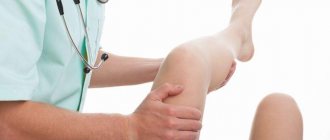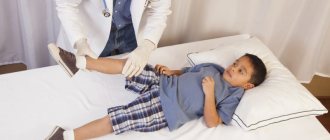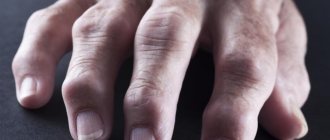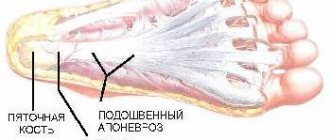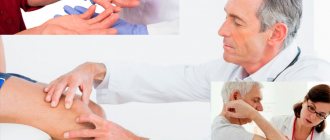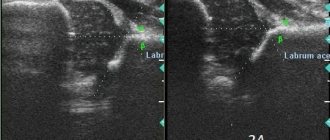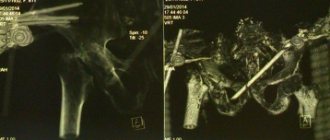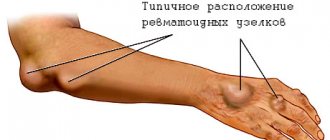Reactive arthritis is an autoimmune disease that develops after infectious diseases and manifests itself in joint damage. Rheumatologists at the Yusupov Hospital make a diagnosis using the latest equipment and laboratory diagnostic methods. Complex therapy is carried out in accordance with clinical recommendations for the treatment of reactive arthritis. Doctors at the therapy clinic individually select medications and use only pharmacological agents registered in the Russian Federation.
Severe cases of the disease are discussed at a meeting of the Expert Council. Candidates and doctors of medical sciences, doctors of the highest category take part in its work. Leading specialists in the field of rheumatology are collectively developing tactics for managing patients with reactive arthritis. The medical staff is attentive to the wishes of patients and their relatives.
The causes of reactive arthritis vary. Reactive arthritis includes all inflammation of the joints that are chronologically associated with any infection. At the same time, no microorganisms were detected in the synovial fluid of the affected joints. The connection between arthritis and a previous infection is confirmed by carefully determining the history of the disease, analyzing the clinical manifestations of arthritis, identifying the pathogen, and detecting high titers of antibodies to it in the blood.
Reactive arthritis occupies one of the leading places in terms of prevalence among rheumatic diseases. Their share is 10-15%. In the general structure of reactive arthritis, the leading position is occupied by urogenic reactive arthritis associated with infection of the genitourinary system. Enterogenous forms of the disease, in which the main focus of infection is localized in the intestine, develop less frequently.
What is reactive arthritis (ReA)
The term “reactive arthritis” was first used more than 50 years ago to name arthritis that develops after yersiniosis in the absence of infectious agents in the joints. But after a few years, this name began to be associated with certain infections of the gastrointestinal tract, genitourinary organs and nasopharynx.
Currently, reactive arthritis is considered to be non-purulent inflammation of the joints, developing no later than 6 to 8 weeks after a urogenital, intestinal or nasopharyngeal infection. ICD-10 code M02.
Young men aged 17–40 years are more likely to get sick after suffering from sexually transmitted infections (women get sick much less often). In children, adolescents, as well as people of any age and gender, reactive arthritis can develop after intestinal infections, as well as infections of the nasopharynx.
The prevalence of ReA in our country among adults is about 43 per 100,000 population, among children - 99, among adolescents - 172. The incidence is growing, which is largely due to genetic predisposition, asymptomatic infections and untimely administration of adequate treatment.
There is also Reiter's syndrome, which develops after a urogenital infection and manifests itself in the form of three main symptoms: arthritis, conjunctivitis and urethritis.
Description
Reactive arthritis is an aseptic inflammation of the joints that occurs against the background of an infection of the ENT organs, intestines or urogenital tract.
Has code M02 according to ICD-10. Develops simultaneously with the underlying disease or 1-4 weeks after its onset. A distinctive feature is asymmetrical damage to the joints in combination with inflammatory changes in the mucous membranes of the eyes, oral cavity, urethra, cervix, etc. In a third of cases, reactive arthritis is completely cured within six months. Another third of patients experience periodic relapses. In 25% of cases, the disease is chronic from the very beginning. In 5% of patients, a severe course is observed with rapidly progressive destruction and dysfunction of the affected joints, limitation or loss of ability to work.
Reasons for development
Experts distinguish 2 types of reactive arthritis:
- Urogenital . Develops against the background of STIs caused by Mycoplasma hominis, Trichomonas vaginalis and other pathogens. The first place among microorganisms that provoke inflammation of the joints is taken by Chlamydia trachomatis - the disease occurs in 1-3% of patients who have had a chlamydial infection. Men are affected 9 times more often than women.
- Enterocolitic . It occurs as a result of infection with microorganisms from the genus Salmonella, Shigella, Yersinia and some others. Enterocolitic arthritis is complicated in 1.5 to 4% of cases of all intestinal infections. The disease is equally often detected in patients of both sexes.
Inflammation of the joints after respiratory and otolaryngological infections (ARVI, tonsillitis) is usually not classified as a separate category. Most often, reactive arthritis affects people aged 20-40 years. Pathology is diagnosed less frequently in children and older patients; in both cases, the enterocolitic variant and consequences from the ENT organs predominate.
Genetic predisposition plays a significant role in the development of articular syndrome. Carriers of HLA-B27 suffer 50 times more often than people who do not have this antigen.
Pathogenesis
Reactive arthritis is based on a distorted immune response. Antibodies attack not only the pathogen, but also antigens (usually HLA-B27) contained in the cells of the joint. Previously, it was believed that arthritis was aseptic in nature, that is, pathogenic microbes did not enter the joint, inflammation occurred only due to an immune failure.
Modern research refutes this idea. Scientists were able to isolate nucleic acids belonging to viable chlamydia from the joint fluid and joint membrane. This proves that microbes (perhaps not all, but only some) penetrate the joint, although it is almost impossible to detect them directly.
Classification
Along with the division of reactive arthritis into urogenital and enterocolitic, the following classifications are used in clinical practice:
- According to the characteristics of the course : acute (up to 2 months), prolonged (up to 1 year), chronic (more than 1 year), recurrent (with repeated exacerbation after the disappearance of all symptoms for six months or more).
- According to the degree of activity : with low (I), medium (II) and high (III) activity, inactive (in remission).
- According to the severity of the dysfunction of the joint : the patient retains the ability to work (I), the ability to work is lost (II), the patient cannot care for himself (III).
Causes of the disease
The main causes of reactive arthritis are past infection and genetic predisposition. Infections that can cause ReA include:
- urogenital form of ReA
– chlymydia, ureaplasmosis, mycoplasmosis; - intestinal form of ReA
– shigenellosis (dysentery), salmonellosis, yersiniosis, intestinal infection caused by Escherichia coli; - nasopharyngeal form
– previous nasopharyngeal infections caused by staphylococcal, streptococcal and other infections.
A previous infection is a trigger (triggering factor) that starts a chain of immuno-allergic and inflammatory reactions. This occurs predominantly in genetically predisposed individuals who have the HLA-B27 antigen in their body, which causes an imbalance in the immune system, which leads to increased formation of prostaglandins and cytokines - biologically active substances that cause inflammation.
A long-term inflammatory process is also supported by incompletely removed infectious pathogens and the appearance of antibodies to them. Reactive arthritis caused by urogenital infection (chlamydia, mycoplasma, ureaplasma), which penetrates cells and remains viable for a long time, takes a particularly long time. Failures in the immune system cause allergic and autoimmune (allergy to the body's own tissues) processes, which also support long-term inflammation.
Symptoms of reactive arthritis
Regardless of the cause of the disease, reactive arthritis develops in the same way. By the time the first symptoms of reactive arthritis appear, all manifestations of the trigger infection end or go unnoticed.
Pain, swelling and redness over the affected joint are some of the first symptoms of reactive arthritis.
The first signs of ReA
The disease begins 3 to 30 days (sometimes more) after the infection, acutely with an increase in body temperature, headache, malaise, and the appearance of an inflammatory process in the joints. More often one or more asymmetrically located joints of the lower extremities are affected. Most often these are the knee, ankle and toe joints.
The skin and subcutaneous tissue over the affected joint are red, swollen, and painful. Sometimes pain immediately appears in the lower back - a sign of damage to the sacroiliac joints and joints of the spine. When the first signs of joint inflammation appear, you should consult a doctor. The Paramita clinic will definitely help you.
Obvious symptoms
Reactive arthritis can occur in the form of:
- acute inflammatory process
– up to 3 months; - subacute
– for 3 – 6 months; - protracted
– 6 – 12 months; - chronic
– more than 12 months; - recurrent
– with relapses and remissions.
In addition to the symptoms of reactive arthritis with pain and dysfunction of the affected joints, damage to periarticular tissues - ligaments, tendons, periarticular capsules (enthesitis) is also characteristic. Particularly characteristic is damage to the heel (subcalcaneal bursitis), accompanied by severe pain and inflammation of the periarticular tissues, as well as the 1st toe with redness and swelling of the tissues - “sausage toe”. Such symptoms can completely disrupt the function of the lower extremities - it becomes impossible to move due to pain.
ReA of urogenital origin is often combined with long-term urethritis in men or cervicitis in women, as well as eye damage (Reiter's syndrome). Eye damage can occur in the form of mild conjunctivitis, but in some cases the deeper membranes of the eye are also affected.
Sometimes with reactive arthritis, psoriasis-like rashes appear on the skin, palms and soles, as well as psoriatic-like lesions on the nails. Painless erosions appear on the oral mucosa. There may also be enlargement of the lymph nodes in the groin area.
Dangerous symptoms
The most dangerous is reactive arthritis associated with urogenital infection. This form of the disease is prone to a long-term relapsing course followed by the formation of a rheumatoid-like course. Therefore, it is very important to promptly and adequately treat arthritis.
Causes of urogenic arthritis
There are two causes of arthritis due to sexually transmitted infections. 1. Direct hematogenous (through blood) introduction of infection into the joints. This option most often occurs in the disseminated form of gonococcal infection. Although some researchers recognize hematogenous introduction (through infected marophages) into the joints of chlamydia, herpes viruses, and ureaplasma. 2. An autoimmune mechanism, in which the body begins to produce autoantibodies to its own tissues, in this case, to the cells of the synovial membrane of the joints. The term urogenic reactive arthritis is used to designate this form. It most often occurs in intracellular forms of parasitism of the pathogen - chlamydial infection (as a component of Reiter's syndrome) and genital herpes. Cases of reactive arthritis are also observed with mycoplasmosis.
The most significant etiological factor in the development of urogenic arthritis is currently recognized as chlamydia - Chlamydia trachomatis. This pathogen was found in scrapings from the urethra and cervical canal of patients with urogenic arthritis. In the presence of anogenital and orogenital contacts, chlamydia can be detected in scrapings from the rectum and pharynx. Currently, chlamydia is the most common sexually transmitted infection, especially among young people and adolescents. It is possible that chlamydia may be present for many years in the joint cavity and cause direct damage to the cells of the articular cartilage.
Another causative agent of urogenital infections is mycoplasma, and the most important among this class of microorganisms are Ureaplasma urealyticum and Mycoplasma genitalium, because The primary habitat of these microbes is the urinary tract and genitals. Quite often, a chlamydial-ureaplasma association is found in people suffering from chronic urethritis. In urogenic arthritis it occurs in 10% of cases. A combination of gonococcal infection with chlamydial and ureaplasma is possible.
The danger of the infections discussed lies in their frequent asymptomatic course. As a rule, patients seek help with the development of complications such as inflammatory diseases of the pelvic organs, reproductive disorders, chronic prostatitis and epididymitis, eye lesions (recurrent conjunctivitis, iritis, iridocyclitis), lesions of the joints and periarticular tissues - arthritis, bursitis, tenosynovitis . In this regard, there are two forms of chlamydia: complicated and uncomplicated. Therapeutic tactics for these clinical forms vary. Urogenic arthritis is a complicated form of urogenital chlamydia or ureaplasma infection. In the development of this complication, an important role is played by the characteristics of the immune response to bacterial antigens, which may be genetically determined.
The frequent combination of gonococcal infections with trichomonas, staphylococcal and viral infections has created conditions for the development of cross-forms of allergies, changes in the immunological reactivity of the body, which contributes to the occurrence of urogenital arthritis. During arthritis, two phases are distinguished: infectious (early) and immunopathological (late). In the late phase of the disease, it is rarely possible to detect microbial antigens.
How dangerous is the disease?
The danger of reactive arthritis is that it can develop into a long-term chronic recurrent disease that is difficult to treat.
Stages of ReA
Any form of arthritis has serious complications, so you should not delay treatment.
See how easily the disease can be cured in 10-12 sessions.
The inflammatory process in the joints occurs in several stages:
- initial
- with an acute onset, general symptoms appear: fever, headache, malaise, as well as inflammation, swelling and tenderness of the joints; At first, the ankle joints and joints of the 1st toe are most often affected; - expanded
- asymmetrical damage to the joints of the legs (from bottom to top), starting from the ankle joints to the knees; pain appears in the lower back associated with damage to the joints of the spine, skin rashes, erosions on the mucous membranes, enlarged lymph nodes; with Reiter's syndrome - conjunctivitis and urethritis; - final
- with intestinal and nasopharyngeal forms of reactive arthritis, the inflammatory process ends after 3 months with recovery; in a subacute course, the process can last up to 6 months and also end in recovery; The urogenital form of ReA often occurs chronically.
Possible complications
Chronic reactive arthritis can cause lameness
Reactive arthritis should be treated as early as possible.
Prolonged inflammation can lead to chronic pain, especially in the heel, foot and toes, leading to lameness.
With a long chronic course of Reiter's syndrome, damage to the optic nerve and blindness is possible, as well as damage to the reproductive system and infertility.
What to do during an exacerbation
If the inflammatory process has taken a chronic, relapsing course, then it is necessary to carry out long-term treatment under the supervision of a physician. When the first signs of relapse of reactive arthritis appear, you should:
- limit physical activity;
- take a medicine from the group of NSAIDs (non-steroidal anti-inflammatory drugs) - Diclofenac, Ibuprofen, Meloxicam; a tablet of any product can be taken orally, and a cream, gel or ointment with the same composition can be applied externally to the area of the affected joint;
- Urgently contact your doctor to prescribe adequate treatment.
Folk remedies
Photo: 365news.biz
Reactive arthritis cannot be cured without eliminating the infection with the help of pharmaceutical drugs selected taking into account the type of pathogen and the characteristics of the course of the disease. Attempts at self-medication can lead to a deterioration in the patient’s condition, the disease becoming chronic, and the development of complications from internal organs.
Folk remedies are recommended only as an auxiliary method. During the recovery stage, baths with Dead Sea salts, chamomile decoction or fresh pine needles are useful. Topically used:
- Oregano ointment . Oregano flowers are poured with olive oil, left for 12 hours, and then applied to the affected joints.
- Hop rub . A mixture of Vaseline, crushed hop cones and juniper essential oil is kept for 7 hours, then rubbed on the joint.
- Burdock compresses . A fresh leaf is kneaded to release the juice and tied to the joint, covered with a soft, warm cloth on top.
- Wormwood compresses . Wormwood inflorescences are poured with boiling water, infused, and filtered. Apply to gauze. Gauze is applied to the joint and covered with a cloth.
The use of any folk remedies is permissible only after the permission of the attending physician. If skin irritation, swelling, or redness occurs, the listed products are contraindicated.
The information is for reference only and is not a guide to action. Do not self-medicate. At the first symptoms of the disease, consult a doctor.
Possible localization of inflammation
In intestinal and urogenital forms of reactive arthritis, the joints of the lower extremities are most often affected. In the nasopharyngeal form - the joints of the upper extremities and the temporomandibular joint.
Arthritis of the lower extremities
Affection of the lower extremities predominantly begins with the big toes and moves upward (staircase sign), affecting the overlying joints asymmetrically. In reactive arthritis, one to five joints become inflamed:
- interphalangeal toes; Most often the first toe is affected, it swells and turns red - the “sausage toe” symptom;
- ankles with damage to surrounding tissues; Particularly characteristic is damage to the tendons and ligaments in the heel area with the formation of loose heel spurs, which causes constant pain that intensifies when walking and stepping on the heel;
- knee – this location is characterized by the formation of a large amount of exudate (inflammatory fluid in the joint), which leads to the formation of popliteal cysts; rupture of cysts leads to the development of thrombophlebitis and impaired venous circulation;
- hip – rarely affected, occurs in the form of moderate joint pain.
Chondroprotectors: what are they, how to choose, how effective are they?
Joint pain at rest
Arthritis of the upper extremities
Localization of reactive arthritis in the joints of the upper extremities is much less common. This mainly occurs in diseases of the nasopharynx and dental infectious and inflammatory processes.
The most common joints affected by ReA are:
- elbow - the elbow swells, turns red, becomes painful, the arm has difficulty bending and unbending;
- wrist with damage to the ligaments and tendons of the hand - pain in the joint is transmitted to the hand; severe pain does not allow you to squeeze and unclench your hand or hold objects in it;
- shoulder – rarely affected, characterized by swelling and pain.
Temporomandibular arthritis
Reactive arthritis affects the joints of the lower and upper extremities, temporomandibular joints
Triggers include infections of the nasopharynx, ear and mouth. Characterized by slight swelling, redness and swelling in the area of development of reactive arthritis. When opening the mouth, there is a slight asymmetry; the chewing process may be disrupted and become painful. The disease occurs acutely or subacutely, is well treated, and the prognosis is favorable.
Medicines
Photo: vk.com
The most important task is to eliminate the infection. Etiopathogenetic therapy is complemented by symptomatic medications. The treatment plan includes:
- Antibiotics . Necessary for chlamydial infection. Doxycycline, clarithromycin, and other drugs from the tetracycline, macrolide, and fluoroquinolone groups are prescribed orally. The duration of the course of antibiotic therapy is 1 month. The effectiveness of antibiotics for intestinal infections has not been proven.
- NSAIDs . Diclofenac, ibuprofen, naproxen, nimesulide are used in tablet form to eliminate pain and inflammation. Due to the possible negative effect on internal organs, they are used in the lowest possible doses in short courses under laboratory monitoring of liver and kidney functions.
- Glucocorticoids . Recommended for severe reactive arthritis. They are administered locally during intra-articular and periarticular blockades. Less commonly prescribed as a means of general action.
- Immunosuppressants . Sulfasalazine is indicated for protracted course, high activity of the process, development of spondyloarthritis. Other drugs in this group for reactive arthritis are currently recognized as ineffective.
Diagnostics
Diagnosis of reactive arthritis includes identifying characteristic manifestations of the disease and confirming the diagnosis with the following studies:
- Laboratory diagnostics:
- general clinical blood and urine tests - these studies reveal the presence of an inflammatory process, anemia;
- biochemical blood tests - total protein and protein fractions, the presence of C-reactive protein (a sign of an inflammatory reaction);
- immunological studies - rheumatoid factor, antibodies to cyclic citrullinated peptides to exclude rheumatoid arthritis; markers of systemic lupus erythematosus;
- detection of the HLA-B27 antigen by testing blood using the PCR (polymerase chain reaction) method, which allows identifying the smallest DNA particles of this protein;
- identification of urogenital, intestinal infections and foci of nasopharyngeal infections using microscopic, microbiological (culture on nutrient media), immunological studies;
- To exclude purulent arthritis, synovial fluid is sometimes examined.
- X-ray of the joints, during which the degree of their damage is revealed.
- Ultrasound - allows you to identify changes in the periarticular tissues.
- Arthroscopy is the examination of the inner articular surface using optical equipment. Rarely used in ReA.
Treatment of reactive arthritis
Only a doctor can cure reactive arthritis after an examination and taking into account its results. Basic principles of treatment of reactive arthritis:
- elimination of inflammation and joint pain;
- suppression of infectious-allergic and autoimmune processes;
- eliminating the trigger infection.
The following types of treatment for reactive arthritis are carried out:
- medicinal;
- non-medicinal;
- using folk remedies.
Drug therapy
Crunching in joints - when to worry
Intra-articular injections of hyaluronic acid
Treatment for reactive arthritis begins with eliminating inflammation, swelling and pain. For this purpose, patients are prescribed NSAID drugs. The most effective medications include Diclofenac, Aceclofenac, Ibuprofen and others in the form of injections, tablets or externally (gels, ointments).
In case of severe swelling and inflammation that cannot be eliminated by NSAIDs, glucocorticoid hormones are prescribed. They are prescribed in courses in the form of tablets orally (Prednisolone), in the form of pulse therapy - short intensive courses intravenously (Methylprednisolone), and also by injection into the joint or periarticular tissue (Hydrocortisone, Diprospan).
If there is a risk of transition to a chronic course, basic therapy is prescribed - drugs that suppress immune reactions: Sulfasalazine, Methotrexate, Azathioprine, etc. Biological agents are also prescribed - biologically active substances (antibodies, cytokines, etc.) that take part in immune reactions ( Mabthera).
For trigger urogenital infections, a long course of antibacterial therapy must be prescribed: antibiotics from the group of macrolides (Clarithromycin), tetracyclines (Doxycycline) or fluoroquinolones (Ciprofloxacin) for a month or more.
For intestinal infections, antibacterial therapy is considered inappropriate. For nasopharyngeal and dental infections, the decision to prescribe antibiotics is made by the doctor individually.
Medicines for the treatment of reactive arthritis
Non-drug treatment
Non-drug treatments include:
- Diet. There is no special diet, but given the allergic component of the disease, foods that cause allergies (eggs, nuts, citrus fruits, red and orange vegetables and fruits, etc.), spicy seasonings, fried, canned, smoked foods, sweets and baked goods are excluded from the diet.
- Physiotherapeutic procedures. In the acute period, to eliminate swelling and pain, electrophoresis with Hydrocortisone is prescribed, and then laser and magnetic therapy. At the recovery stage, sanatorium-resort treatment with balneo and mud therapy is recommended.
- Reflexology courses.
- PRP therapy is the stimulation of the body’s regenerative abilities by introducing the patient’s own plasma enriched with platelets.
- Therapeutic exercises and massage are carried out after eliminating the acute inflammatory process.
Folk remedies
Treatment of reactive arthritis with folk remedies is often included in complex treatment to enhance the effectiveness of drugs and reduce the drug load on the patient’s body. Folk remedies are selected for each patient individually, depending on the nature of the disease.
Self-treatment of reactive arthritis with folk remedies is ineffective.
Doxycycline in rheumatology: problems and prospects
IN
In the 21st century, infectious pathology remains one of the most significant problems in medicine. In rheumatology, the relevance of this issue is due to at least two factors. Currently, the role of various infectious agents in the development of rheumatic diseases (RD) is well known and proven, in which microorganisms play a trigger role, triggering immunopathological mechanisms of inflammation. An equally difficult task is the fight against concomitant infections, which often complicate the course of many RDs.
Despite the extensive arsenal of antimicrobial agents developed and introduced into clinical practice in the second half of the last century, issues of rational therapy of infectious pathology still require the closest attention.
both medical scientists and practical doctors of various specialties. Identification of new pathogens, the growing role of opportunistic microflora, an increase in the number of resistant microorganisms, inferiority of the immune response, issues of tolerability and interaction with antirheumatic drugs, pharmacoeconomic aspects - all this requires constant awareness of the rheumatologist about the basic principles of rational therapy of bacterial infections in RD.
The emergence of new antibacterial agents in recent years has significantly expanded the possibilities of practical antimicrobial therapy both in rheumatology and in all medicine. At the same time, in a number of clinical situations, time-tested, much less expensive antibacterial agents still retain their importance. The latter includes doxycycline.
Doxycycline
– a semisynthetic antibiotic from the tetracycline group – was created in 1967 and has been widely used in clinical practice for many years. Its chemical structure is 6-dioxy-5-oxytetracycline and has a mechanism of action common to all tetracyclines. At clinically achievable concentrations, it acts bacteriostatically, disrupting protein synthesis in the microbial cell by binding to the 30 S RNA subunit of ribosomes.
Compared to tetracycline, doxycycline has a number of pharmacokinetic advantages (Table 1): a greater degree of absorption from the gastrointestinal tract and less influence of food and milk on this process; longer half-life (which allows you to prescribe the drug 1-2 times a day); good penetration into various tissues due to its lipophilicity; the absence of cumulation of the drug in the blood due to increased excretion in feces and increased metabolism in case of impaired renal function, which makes it possible to use it in patients with renal failure. Due to its special pharmacokinetic properties, doxycycline is much easier to tolerate than tetracycline. Side effects are even rarer when taking Unidox Solutab
. The neutral reaction of doxycycline monohydrate eliminates the occurrence of esophagitis that occurs when using other forms of doxycycline. Consequently, the successful combination of the chemical formula (monohydrate) and dosage form (soluble Solutab tablets) makes the drug the safest, and treatment with its help the most compliant.
Doxycycline, like other tetracyclines, is a broad-spectrum antibiotic, but over many years of use, many bacteria have become resistant to it.
In particular, more than 50% of S. pyogenes strains, the vast majority of enterococci, and many gonococci are resistant to the drug. Most strains of E. coli, Salmonella, Shigella, and Enterobacter are also highly resistant to the drug. Based on the above, doxycycline is not used for A-streptococcal tonsillitis, urinary tract infections, gonorrhea, etc. At the same time, it retains its importance as a first-line drug for many infections and in a number of situations can be used as an alternative remedy ( Table 2). Works in recent years have shown that doxycycline, like other tetracyclines, also has other properties that make it possible to talk about expanding the indications for the use of these drugs, in particular for RD.
Doxycycline has found wide use in the treatment of sexually transmitted diseases, since Chlamydia trachomatis is one of the most significant factors in these diseases.
According to the Center for Disease Control (CDC), in 1999 in the United States, the incidence of chlamydial infections was 254 cases per 100,000 population. Chlamydial infections were most often found in young women aged 15–24 years [3]. This pathogen accounts for 30–50% of cases of nongonococcal urethritis; much less frequently, U. urealyticum and M. genitalium (10–20%) appear as etiological factors. In accordance with CDC recommendations [4], for the treatment of patients with acute nongonococcal urethritis,
doxycycline 100 mg orally twice a day for 7 days or azithromycin 1 g orally once is used. According to numerous studies, the effectiveness of both regimens is approximately the same, but the cost of treatment with azithromycin is significantly higher than when using doxycycline.
A significant proportion of chlamydial infections are asymptomatic, especially in women, and can lead to infertility and pelvic inflammatory disease. In these cases, as with nongonococcal urethritis, doxycycline and azithromycin are first-line drugs. It should be remembered that doxycycline, like other tetracyclines, should not be given to children under 8 years of age, since these drugs can cause slower bone growth, discoloration of teeth, and enamel hypoplasia. Given the possibility of tetracyclines passing through the placenta, as well as into breast milk, they are contraindicated during pregnancy and lactation.
Doxycycline is used in combination with other antibiotics
(ampicillin/sulbactam, ciprofloxacin, metronidazole) for the treatment of inflammatory diseases of the pelvic organs, as well as in patients with syphilis with intolerance to b-lactam antibiotics.
Given the sensitivity of the main respiratory pathogens to doxycycline, the drug remains important in the empirical treatment of infectious exacerbations of chronic bronchitis, as well as community-acquired pneumonia that does not require hospitalization, especially in young people. In case of proven chlamydial or mycoplasma etiology of community-acquired pneumonia, doxycycline, along with macrolides, is used as a first-line agent.
Reactive arthritis
The leading role in the pathogenesis of reactive arthritis (ReA), including Reiter's disease (RD), is played by an infectious focus in the genitourinary tract. In this case, Chl is recognized as the most significant etiological agent. trachomatis. This pathogen as a trigger triggers immunopathological processes in the human body, leading to the occurrence and maintenance of joint inflammation. Persistence of infection, in turn, leads to recurrence and chronicity of the articular process in ReA.
The role of Chl. trachomatis in urogenic ReA is confirmed by the presence of this infectious agent in scrapings of the epithelium of the urethra and cervical canal (where there are signs of nongonococcal inflammation), the detection of chlamydial antigens in the synovial fluid of patients, and the detection of DNA and RNA of this pathogen in the synovial fluid and tissue.
Numerous studies have substantiated the advisability of early prescription of antibiotics for ReA
associated with chlamydial infection. This allows you to control the pathological process, and in some cases prevent the development of joint damage. Although no convincing data have been obtained on the effect of antibiotics on the course of articular syndrome, when chlamydial infection is eliminated, relapses and chronicity of the disease occur less frequently.
It should be noted that sanitizing the body of a patient with ReA from chlamydial infection is a rather difficult task. It has been shown that with urogenic ReA in almost all patients, the inflammatory process in the urogenital tract is not limited to the urethra, but spreads to its overlying parts, which significantly complicates the sanitation of this focus. [5]. This circumstance, to a certain extent, may serve as an explanation for the fact that 7–10 day courses of antibiotic therapy used to treat uncomplicated urogenital chlamydia are completely ineffective for ReA associated with chlamydial infection. However, even with adequate long-term antimicrobial therapy, the rate of bacteriological failures in BD can reach 40%, which is apparently due to the biological characteristics of the pathogen.
It is known that the carriers of the species characteristics of chlamydia - elementary bodies - are metabolically inactive, exist in the extracellular environment and can remain dormant for an indefinitely long time. Moreover, patients with ReA who have previously been treated with antibiotics may develop a persistent infection, when the initially metabolically active reticular bodies localized inside the cell stop at a certain stage of development and do not turn into elementary bodies. These intermediate forms, compared to conventional ones, are smaller in size and are not sensitive to the action of antibiotics.
Antibiotics of the tetracycline group have been used to treat BD since the late 1970s. Thus, long-term use of high daily doses (up to 2 g/day) of tetracycline in fresh cases of BD gave a significantly better therapeutic effect than when using relatively small doses (up to 1 g/day) [6]. The advantages of a 6-week course of treatment with tetracycline for BD in relation to indicators of chlamydial infection and joint syndrome compared with a 2-week period of therapy have been shown [7]. Use of lymecycline in patients with ReA for 3 months. made it possible to achieve a more rapid reverse development of both individual symptoms (arthralgia, accelerated ESR, increased levels of C-reactive protein) and the disease as a whole [8]. A comparative study examined the effectiveness of doxycycline, prescribed at a dose of 200 mg/day for 2 weeks or 4 months, in 42 patients with ReA, while the duration of the disease was more than 6 months. Remission was achieved in 73 and 82%, respectively, but the differences were not statistically significant [9].
In general, recognizing the need for long-term use of antibiotics (including doxycycline) for ReA associated with chlamydial infection, it should be noted that there is no consensus on treatment regimens in the world literature. Extending the duration of treatment (more than 3 months), as well as parenteral administration of antibiotics, is unlikely to increase the effectiveness of therapy [10]. Further clinical studies are needed to resolve this issue.
Lyme borreliosis
In recent years, Lyme borreliosis (LB), an infectious natural focal disease caused by spirochetes of the genus Borrelia and transmitted by ixodid ticks, has attracted increasing interest from medical specialists, including rheumatologists. First attracting attention in 1975 during a local outbreak of arthritis in Lyme (USA), BL is currently considered as a multisystem disease that affects not only the musculoskeletal system, but also the skin, nervous system, heart, liver, and eyes. etc. After Borrelia penetrates the skin, erythema with centrifugal growth appears at the site of tick suction (tick-borne migratory erythema - TME), which reflects the early stage of the disease. Subsequently, dissemination of the pathogen from the primary skin lesion to various organs and its persistence in tissues (stage of late manifestations) may occur.
Rheumatic manifestations typical of BL (arthritis and arthralgia, tendonitis, myositis, enthesopathies, fibrositis) develop after dissemination of the causative agent to the target organs. Neurological manifestations of BL are represented by symptoms indicating damage to both the central (meningitis, encephalitis, myelitis, encephalopathy) and peripheral nervous system (cranial neuropathies, radiculopathy, etc.). The most typical signs of heart damage, developing 3–12 weeks from the onset of the disease, are atrioventricular blocks of varying severity (from first to complete) [11].
It has been shown that early (i.e. prescribed for CME) antibacterial therapy reduces the risk of developing secondary erythema, damage to joints and blood vessels and, therefore, is an important factor in the further favorable course of BL
. A high degree of correlation was revealed between treatment started in the first month of the disease and recovery. Thus, in BL, the prognosis clearly correlates not only with optimal antibacterial therapy, but also with the early timing of its initiation [12]. In relation to rheumatology, this means that timely adequate treatment of local skin infection is essentially the primary prevention of the development of arthritis and other systemic manifestations of BL.
In accordance with the recommendations of the Infectious Diseases Society of America [13], the first-line drugs for the treatment of early (local and disseminated) stages of BL are doxycycline
(100 mg twice daily orally) or
amoxicillin
(500 mg three times daily orally) given for 14–21 days. According to prospective studies, these drugs have demonstrated similar effectiveness in the treatment of CME and associated symptoms of LD in the absence of neurological manifestations and/or third degree atrioventricular block. Cefuroxime-axetil, which is similar in effectiveness to doxycycline in the treatment of CME, is considered an alternative drug for this category of patients due to its high cost.
Of particular interest is a comparative randomized study of 11 treatment regimens performed in Russia in a large group of patients with CME. Significantly better results were obtained with the use of doxycycline (0.2 g per day per os for 14 days) compared with penicillin (2 million units per day intramuscularly for 10–14 days) and tetracycline (1.2 g per day for within 14 days). The use of cefuroxime at a dose of 1 g per day gave results similar to those of doxycycline treatment. The optimal treatment result was observed when antibiotics were prescribed in the first 5 days of illness, and the duration of the course of antibiotic therapy was at least 14 days [14].
With the development of Lyme arthritis, in accordance with American recommendations, the administration of doxycycline or amoxicillin in the above doses for 28 days is indicated. If, after a course of treatment, a relapse of arthritis develops, it is advisable to prescribe another antibiotic for oral administration or use ceftriaxone for 2–4 weeks (but not earlier than 3–4 months from the end of the previous course of antibacterial therapy).
The results of a special epidemiological experiment conducted in Russia on a large group of patients deserve undoubted attention. The high effectiveness of short-term antibacterial therapy has been established according to the indications of rapid diagnosis of borrelia in the intestines of ticks, as a method of preventing tick-borne borreliosis. The use of doxycycline 0.2 g per day orally for 3–5 days after a tick bite reduced the incidence by 11 times [15].
Doxycycline - a basic antirheumatic drug?
For rheumatologists, interest in antibacterial drugs is by no means limited to their direct antimicrobial effect. Equally worthy of attention are the anti-inflammatory and immunomodulatory effects that a number of antimicrobial and antiparasitic agents have revealed in numerous experimental and clinical studies. These include drugs of the tetracycline group.
Currently, there is quite strong evidence indicating the advisability of using tetracyclines, including doxycycline, as basic agents in the treatment of RD, in particular rheumatoid arthritis and osteoarthritis (Table 3). One of the factors determining the anti-inflammatory activity of tetracyclines is the ability of these drugs to inhibit matrix metalloproteinases - specific zinc-dependent enzymes (collagenases, gelatinases, stromelysins, etc.) that play an important role in the degradation of macromolecules of the extracellular matrix of connective tissue. It is assumed that in rheumatoid arthritis and osteoarthritis there are local imbalances between the production of activated forms of metalloproteinases and their tissue inhibitors.
There are reports in the literature of
the successful use of doxycycline in rheumatological patients
. Use of this drug at a dose of 150 mg/day for 3 months. in patients with rheumatoid arthritis led to clear positive dynamics in a number of indicators (joint count, pain intensity determined by visual analogue scale, decreased collagenase activity in saliva, various psychopathological parameters) [16]. In a 6-month pilot study of 23 patients with rheumatoid arthritis, the effectiveness of doxycycline was comparable to that of methotrexate [17]. The results obtained deserve serious attention and clearly indicate the promise of work in this direction.
On the other hand, the proven fact of inhibition of matrix metalloproteinases and a pronounced increase in the penetration of doxycycline into cartilage tissue, the subchondral bone layer and the synovium in the presence of flurbiprofen led to the conclusion that it is advisable to conduct clinical trials of doxycycline for osteoarthritis with an expected treatment period of 12 to 18 months. [18].
Thus, doxycycline still remains one of the most interesting and promising antibiotics
. Further use of this drug will, in all likelihood, expand the range of indications for its use both in rheumatology and in other areas of clinical medicine.
A complete list of references can be found on the website https://www.rmj.ru
References:
1. Joshi M., Miller DQ Doxycycline revisited. Arch. Intern. Med. 1997; 157:1421–1428.
2. Navashin S.M., Navashin P.S. Tetracyclines in the treatment of bacterial infections. Antibiotics and chemotherapy. 1993; 38(1): 53 – 62.
3. Division of STD Prevention. Sexually Transmitted Disease Surveillance, 1999. Atlanta, 2000, Sept.
4. CDC. 1998 Guidelines for treatment of sexually transmitted diseases. MMWR. 1998; 47: 1 – 117.
5. Kovalev Yu.N., Ilyin N.I. Reiter's disease. Chelyabinsk, 1993.
6. Sidelnikova S.M., Agababova E.R., Stysin E.A., Martynova V.R., Shcherbakova N.I., Bagdasarov A.B. Clinical symptoms and some issues of treatment of Reiter's disease. Ter. archive. 1978; 6: 99 – 103.
7. Khamraev A.A. The effect of antibiotics on clinical symptoms and indicators of chlamydial infection in urogenic Reiter's disease. Author's abstract. diss. Ph.D. honey. Sci. M., 1990.
8. Lauhio A., Leirisalo–Repo M., Lahdevirta J., Saikku P., Repo H. Double–blind, placebo–controlled study of three–month treatment with lymecycline in reactive arthritis, with special reference to Chlamydia arthritis. Arthritis Rheum. 1991; 34: 6 – 14.
9. Wollenhaupt J., Hammer M., Pott HG, Zeidler H. A double-blind placebo-controlled comparison of 2 weeks versus 4 months treatment with doxycycline in chlamydia-induced arhritis. Arthritis Rheum. 1997; 40: S.143.
10. Sieper J., Braun J. Treatment of reactive arthritis with antibiotics. Br. J. Rheumatol. 1998; 37 (7): 717 – 720.
11. Ananyeva L.P. Lyme disease is a multidisciplinary problem. Selected lectures on clinical rheumatology. Ed. V.A., Nasonova, N.V. Bunchuk. M., Medicine, 2001: 148 – 158.
12. Barskova V.G. Rheumatic syndromes in various outcomes of Lyme disease. Author's abstract. diss... cand. honey. Sci. M., 1995.
13. Wormser GP, Nadelman RB, Dattwyller RJ, Dennis DT, Shapiro ED, Steere AC et al. Practice guidelines for the treatment of Lime disease. Clin. Infect. Dis. 2000; 31 (Suppl.1): 1 – 14.
14. Laikovskaya E.E. Study of the effectiveness of antibacterial therapy at the early stage of Lyme borreliosis (Lyme disease) with long-term prospective observation. Author's abstract. diss. Ph.D. honey. Sci. M., 1997.
15. Moskvitina G.E. Emergency prevention of ixodid tick-borne borreliosis based on indication of the pathogen in attached ticks. Author's abstract. diss. Ph.D. biol. Sci. M., 1996.
16. Nordstrom D., Lindy O., Lauhio A., Sorsa T., Santavirta S., Kontinen GT Anti–collagenolytic mechanism of action of doxycycline treatment in rheumatoid arthritis. Rheumatol. Int. 1998; 17(5): 175 – 180.
17. Sreekanth WR, Handa R., Wali JP, Aggarwal P., Dwivedi SN Doxycycline in the treatment of rheumatoid arthritis – a pilot study. J. Assoc. Physicians India. 2000; 48(8): 804 – 807.
18. Ryan ME, Greenwald RA, Golub LM Potential of tetracyclines to modify cartilage breakdown in osteoarthritis. Curr. Opin. Rheumatol. 1996; 8: 238 – 247.
Approach to treating the disease in our clinic
When a patient is admitted to the clinic with symptoms of reactive arthritis, a mandatory comprehensive examination is carried out before prescribing complex treatment. At the same time, the patient undergoes emergency procedures to eliminate inflammation and pain. This includes drug treatment, acupuncture, physiotherapy, etc. After the examination, a comprehensive treatment is prescribed, which includes:
- modern Western methods of treatment using the latest drugs, treatment regimens and non-drug methods aimed at eliminating the symptoms of reactive arthritis;
- traditional oriental treatment methods aimed at restoring the health of the entire body, including joint function.
This approach allows you to quickly and effectively completely cure reactive arthritis.
General clinical recommendations
In the acute and subacute course of ReA, after a course of treatment, the patient should be under the supervision of a rheumatologist for six months with clinical and laboratory monitoring every 3 months.
In the chronic course of the disease, dispensary observation is longer with the prescription of courses of anti-relapse therapy until a state of stable remission appears.
After an illness, it is recommended to avoid heavy physical activity and strength sports. Swimming is a good way to restore joint function.
Persons with a genetic predisposition (presence of the HLA-B27 antigen) to reactive arthritis are recommended to have one proven sexual partner.
We combine proven techniques of the East and innovative methods of Western medicine.
Read more about our unique method of treating arthritis
FAQ
Is reactive arthritis contagious?
No. But the urogenital infection that caused it can persist for a long time and be contagious.
Are there any peculiarities of the course, diagnosis, treatment in children?
In children, ReA is more acute and rarely becomes chronic.
What prognosis do doctors usually give?
The prognosis for reactive arthritis is favorable; in most cases, complete recovery occurs. But if left untreated, it becomes chronic with a long course and constant pain in the joints.
Reactive arthritis is a complex, incompletely studied infectious-allergic disease that mainly affects genetically predisposed people and requires timely and adequate treatment. It's not worth running.
But if you were unable to seek medical help in time, do not despair, modern technologies make it possible to provide assistance and relieve pain at any stage of the disease. The Paramita clinic (Moscow) will always help you.
Literature:
- Agababova ER, Bunchuk NV, Shubin SV, etc. Criteria for the diagnosis of reactive arthritis (draft). Scientific and Practical Rheumatology 2003;(3):82–3.
- Kovalev YN, Ilyin NI. Reiter's disease. Chelyabinsk: Option-book; 1993. 240 p.
- Zeidler H, Hudson AP. New insights into Chlamydia and arthritis. Promise of a cure? Ann Rheum Dis. 2014;73:637–44. doi:1136/annrheumdis-2013-204110.
- Ford D.K. Natural history of arthritis following venereal urethritis. Ann Rheum Dis. 1953;12(3):177–97. doi: 10.1136/ard.12.3.177.
Themes
Arthritis, Joints, Pain, Treatment without surgery Date of publication: 10/13/2020 Date of update: 12/14/2020
Reader rating
Rating: 5 / 5 (2)
